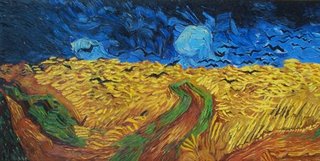How Did Van Gogh Paint Perfect Turbulence?

Scientists at the University of Mexico have announced that Vincent Van Gogh's famous "Starry Night" painting, as well as others painted during periods of documented psychosis, follow the criteria of Kolmogorov scaling for what scientists call turbulence and "intuited the deep forms of fluid flow."
The researchers took digital images of the paintings and calculated the probability that two pixels a certain distance apart would have the same brightness, or luminance. "The eye is more sensitive to luminance changes than to colour changes," they say, "and most of the information in a scene is contained in its luminance."
Several of van Gogh's works show Kolmogorov scaling in their luminance probability distributions. To the eye, this pattern can be seen as eddies of different sizes, including both large swirls and tiny eddies created by the brushwork.

Other Expressionist painters, even those who explicitly painted fluid flow, as in Edvard Munch's "The Scream," did not produce work displaying these qualities, nor did paintings Van Gogh produced in what he described in his own journals as a state of calm. As physicist Jose Luis Aragon of the National Autonomous University of Mexico in Queretaro put it: "We think that van Gogh had a unique ability to depict turbulence in periods of prolonged psychotic agitation."
[From Nature. Images: Top, "Starry Night" (1889); "Wheat Field With Crows" (1890).]

No comments:
Post a Comment